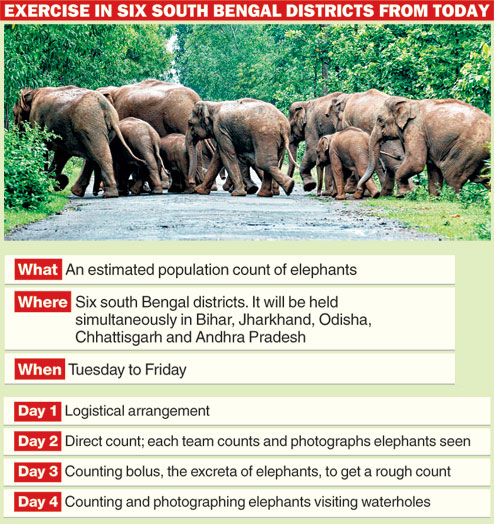
May 8: Hundred and two teams will span out in the forests of six southern districts of Bengal from tomorrow to count elephants.
The exercise till Friday will be carried out simultaneously in Bihar, Jharkhand, Odisha, Chhattisgarh and Andhra Pradesh.
The purpose of synchronising the elephant population estimation is to reduce mistakes like double counting of the animals.
The states form the east-central region of the nationwide exercise. In Bengal, the southern districts inhabited by elephants share boundaries with Odisha and Jharkhand.
A similar exercise was carried out in the districts of north Bengal along with the Northeastern states in March.
Metro decodes the exercise.
When?
The teams will take positions inside the forests tomorrow.
On Wednesday, the direct count will be done by seeing. The next day, the team will count the excreta to get an estimate of the number of elephants in the zone.
On Friday, the teams will seat near waterholes throughout the day to count the number of elephants visiting them to drink water.
Besides counting, the animals will be categorised based on age, sex, and if they have tusks or not.
The districts
Purulia, Birbhum, Bankura, East Burdwan, West Burdwan and West Midnapore.
These are the six south Bengal districts where elephants are found.
Of these, the maximum number of elephants are found in West Midnapore's Goaltore, Lalgarh, Jhitka and Chandra.
Bankura's Joypur, too, has a good number of elephants.
The method
The six districts have been divided into 102 blocks, each of which will have a team assigned to it.
On Wednesday, each team will criss-cross its block counting the number of elephants seen.
A person will be posted at the meeting point of two blocks to keep tabs on elephants, if any, crossing over. That way double counting can be eleminated.
On Thursday, the line transect dung count method will be followed.
An observer from each team will walk down the elephant corridor in his team's block and count the number of bolus, excreta, he sees.
On Friday, the teams will station themselves near waterholes in their blocks to count elephants when they arrive in herds to drink water.
"The teams will stay put throughout the day. Elephants generally come near waterholes between 5am and 7am and between 3.30pm and 6pm," Subhankar Sengupta, the state conservator of forests (wildlife), said.
The teams will take pictures on all the days for documentation but the emphasis on taking good pictures is more on the last day.
First such exercise?
No. There is already a mechanism for the state forest department to count the number of elephants every day.
The information is passed on to villagers and panchayats to avoid elephant-human conflict when a herd approaches a village, a forest official said.
North Bengal has 500-odd elephants and the count in south Bengal is 70, he said. The numbers keep changing as elephants migrate to neighbouring states and again come back, he said.
How is this different?
There's always been chances of mistakes because of migration.
The same elephant counted in Bengal this month could be spotted in a neighbouring state next month when a count is done there.
Also, earlier population estimations were carried out every five years without a uniform methodology.
This time, all states have been asked to create a database with multiple sections - males, females, adults, calves and tuskers - apart from the numbers.
The team
Each team will have four members - three from the state forest department and one from an NGO involved in wildlife conservation.
The date for results
The data will be sent to the Asian Nature Conservation Foundation, a non-profit organisation working for the conservation of Asian Elephants, in Bangalore.
The organisation is coordinating the nationwide exercise on behalf of the central government.
All states inhabited by elephants will send their reports to the organisation, which would analyse and create a pan-India report.
India's elephant population stood at 30,000 during the last synchronised count in 2012.










